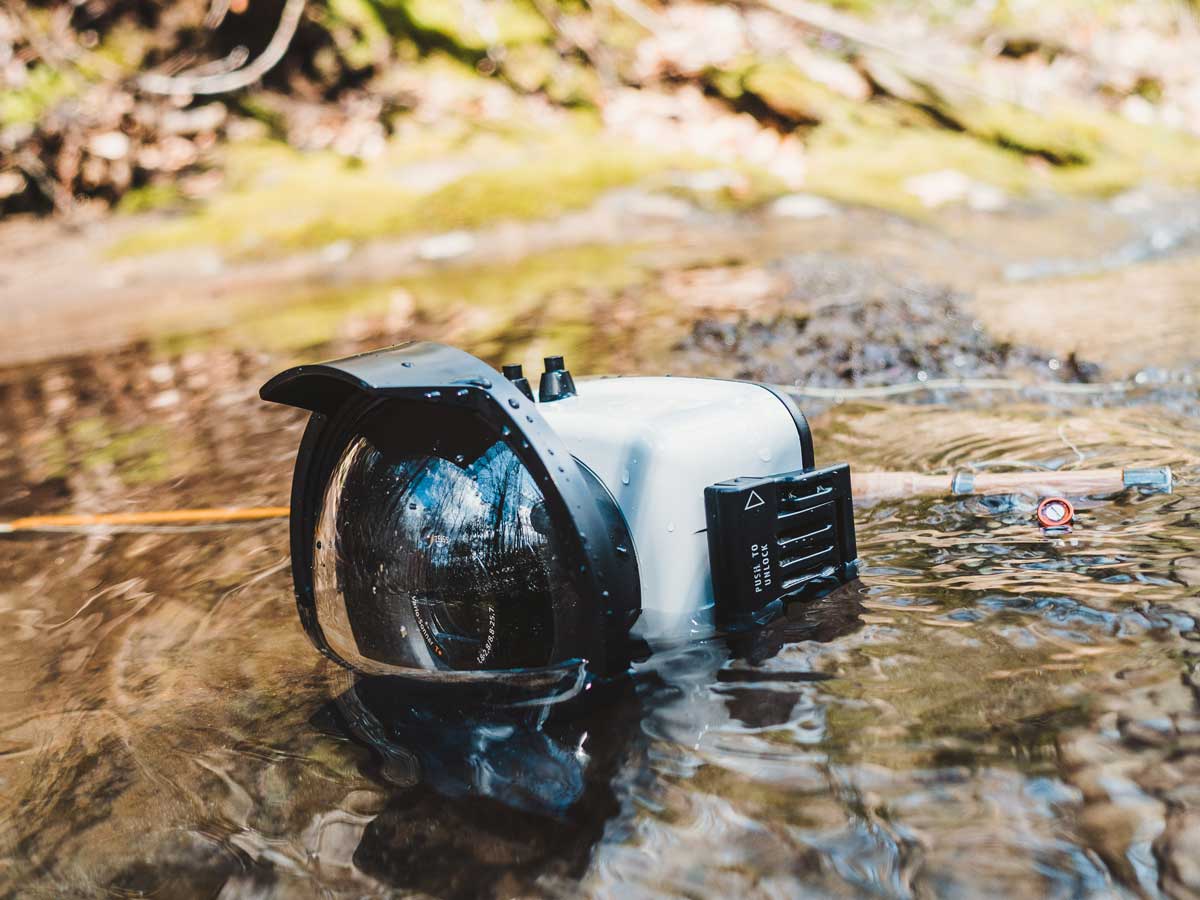By Jean Rydberg
A dome port is the gold standard for wide angle photography underwater. This has everything to do with the way light bends as it goes between water and air.
Do you remember from your open water scuba class that everything looks larger underwater when you’re wearing a dive mask? When you look through a flat piece of glass (or plastic) underwater, everything will appear 33% larger. The same thing happens when your camera is looking through a flat port on an underwater housing. The magnification reduces how much the camera can fit in the frame, effectively reducing its maximum angle of coverage.

Underwater a dome allows you to fit more in your frame than a flat port. This gives you more crisp and vibrant image. At the surface of the water, a dome allows you to shoot split shots with a smooth, even waterline. Photo by Dave Fason
A dome works differently. It gives the camera its true natural perspective underwater. This allows you to capture more in a frame- a 25% increase in angle of coverage. That might not seem like a lot, but it makes a noticeable difference in portrait and wide angle photography.
Being able to fit more in the frame is great for larger subjects like big animals and wrecks. It also improves the color saturation and clarity overall, regardless of subject matter.

A dome allows you to capture 25% more than you would when shooting with a flat port underwater. This can make a substantial difference especially with larger subjects like divers, sharks, and wrecks.
Domes and Over-Unders
Over-unders, where the frame is half above water and half underwater, are one of the most engaging types of underwater photography. These "split" shots really draw the viewer in by showing the familiar surface view juxtaposed against things that are normally hidden beneath the waterline. Dome ports are a must-have accessory for over-under photography.

An over-under image can really capture a sense of place by blending what's happening on the surface with what's going on underwater.
One key element of an over-under shot is the waterline. The position of the waterline dramatically affects the image. A perfectly flat and smooth waterline provides a seamless transition between land and sea. A curved waterline adds a feeling of action and movement to an image.
A dome has more surface area than a flat port. This lengthens the waterline and makes it easier to control its position in the image.

A smooth waterline may be preferred in scenic shots, but a dramatic curved waterline captures the movement and personality of a live subject.
External Wide Angle Lenses
Externally attached wide angle lenses or wide angle domes (sometimes called air lenses) are designed to have water between the flat port of the housing and the back of the lens. This creates a double waterline effect when shooting over-unders. Double rainbows may be cool, but double waterlines are not. The double waterline is very difficult to control and can obliterate a significant portion of the frame.

A long, flat waterline on the left provides a seamless transition between above and below. The photo on the right shows how a waterline can completely obliterate a subject from your photo, in this case a shark.
The DC-series dome port replaces the housing’s original port, so there is no water interfering between the dome and the camera’s lens. This is crucial to capturing the classic shot with one thin waterline.
Focus
A dome port creates an apparent image underwater that is much closer than the actual subject. This affects your camera’s autofocus functioning. Some cameras like the Olympus Tough TG series, can focus through their entire zoom range behind a dome. Other cameras may only be able to focus through a portion of their zoom range.
If your camera has a macro focusing function, turn it on to allow it to focus properly behind a dome. Turning the macro focus function on does not affect the angle of coverage- it simply allows the camera to focus on the apparent image.
The DC4 Dome Port shown on the Action Housing for the Sony Cyber-shot RX100 V. This combination is super lightweight and perfectly simple. Photo by Dave Fason
Ease of Use
The DC series dome ports replace the housing’s original port and are waterproofed to the front of the housing. Once you install it and test it you are good to go. You can shoot macro behind the dome by zooming in to the farthest point that still allows your camera to obtain focus.

A split shot taken with the Olympus Tough TG-5 and DC1 Dome Port. A gradient filter was used in Adobe Lightroom to add the artistic half-monotone effect.
Conclusion
In summary, a DC series dome port is ideal for shooting over-unders. They are also the perfect choice if you’re looking for something simple to use that allows you to shoot both wide and macro on the same dive without fumbling with external accessory lenses.
The DC series dome ports are lightweight, affordable, and comfortable to handle underwater. They are a great addition to the Olympus Tough TG-series, Sony Cyber-shot RX100 series, and most popular compact digital camera models. Check compatibility here.
Additional Reading
How to Shoot Split Shots (Half-In, Half-Out of the Water)
Over-Under (Split Shots) Underwater Camera Settings














